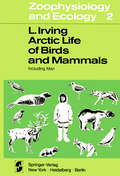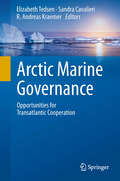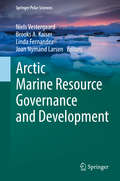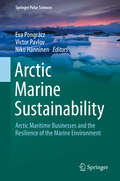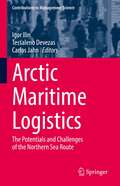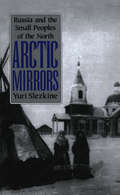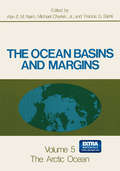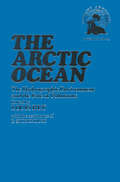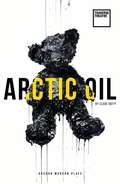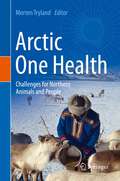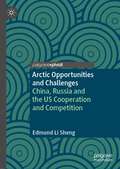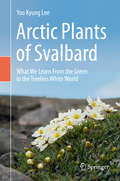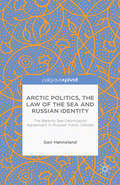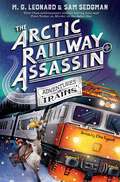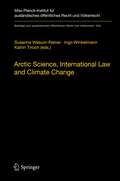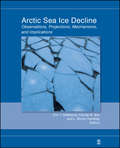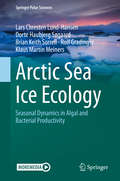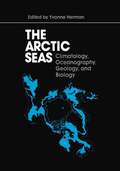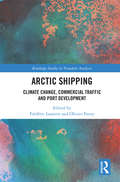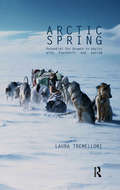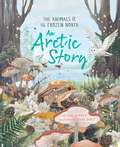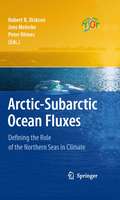- Table View
- List View
Arctic Life of Birds and Mammals: Including Man (Zoophysiology #2)
by L. IrvingAfter travel through Alaska during the Second World War, in 1947 I went to Barrow with a very lively group of biologists. From their productive research developed the Arctic Research Laboratory. While we examined the rather surpris ingly modest metabolic rates of arctic warmblooded animals in cold, PER SCHO LANDER proposed and then carried out measurements of metabolism of some tropi cal animals in Panama. The differences could be formulated to show the basis of adaptation to arctic cold and to tropical warmth. Imagination and logic were required to formulate the comparison so that it could become a part of science, but the essential measurements were derived from animals and plants in their own arctic and tropical environments. Characteristics that adapt the forms of life to climatic conditions of various environments appear clear in the large dimensions of extremely differing climates. At the time of my arrival in Alaska many of the arctic Eskimos were still largely dependent on natural resources of their immediate and local environment, in which great seasonal changes in temperature and solar radiation appeared as dominant factors. The living environment on which they subsisted was also mar kedly affected by the changes of the seasons, in particular by the change in state of water to ice that terminated summer and by the melting that brought the late transition from winter to summer.
Arctic Marine Governance: Opportunities for Transatlantic Cooperation
by Elizabeth Tedsen Sandra Cavalieri R. Andreas KraemerThe Arctic region plays an important role in regulating the world’s climate and is also highly impacted by climate change, with average temperatures rising almost twice as fast as the rest of the world and sea ice melting much faster than previously predicted. These rapid changes will have significant impacts on human activity in the region and on the Arctic marine environment. This book draws on the results of the 2008-2009 Arctic TRANSFORM project, funded by the European Commission‘s Directorate General of External Relations, which engaged experts in a transatlantic discussion on the roles of the European Union and United States in light of the Arctic’s changing climate and political and legal complexities. . The book addresses the significant changes and developments in the marine Arctic, with descriptions and recommendations reflecting the current governance environment. A comprehensive overview of environmental governance and sustainable development in the Arctic is created. Chapters explore impacts and activities by sector, looking at fisheries, shipping, and offshore hydrocarbon in the Arctic, and at policy options and strategies for improving marine governance in the region. A particular focus is given to the roles of the European Union and United States and opportunities for cooperation to enhance Arctic environmental governance. .
Arctic Marine Resource Governance and Development (Springer Polar Sciences)
by Niels Vestergaard Brooks A. Kaiser Linda Fernandez Joan Nymand LarsenThis book is based on presentations from the Conference ‘Arctic Marine Resource Governance’ held in Reykjavik Iceland in October 2015. The book is divided into four main themes: 1. Global management and institutions for Arctic marine resources 2. Resource stewards and users: local and indigenous co-management 3. Governance gaps in Arctic marine resource management and 4. Multi-scale, ecosystem-based, Arctic marine resource management’. The ecosystem changes underway in the Arctic region are expected to have significant impacts on living resources in both the short and long run, and current actions and policies adopted over such resource governance will have serious and ultimately irreversible consequences in the near and long terms.
Arctic Marine Sustainability: Arctic Maritime Businesses and the Resilience of the Marine Environment (Springer Polar Sciences)
by Eva Pongrácz Victor Pavlov Niko HänninenThis book presents the latest scientific views on resource use conflicts in the Arctic seas. The main areas of focus are the biological resources of Arctic seas vs. exploitation of oil and gas resources, and the conflicts in between. In addition, climate change is presented as a stressor, which both limits and facilitates the economic availability of resources in the Arctic. The book is divided into five parts. Part 1 examines Arctic ecosystems, resilience of the marine environment and possible conflicts between industrial sector and biological world. The focus of Part 2 is on transport infrastructure along the northern routes. Issues such as Arctic maritime operations, black carbon and unmanned aerial vehicles are considered. Part 3 focuses on resource use conflicts in Arctic seas and on the most recent threats in terms of Arctic oil and gas exploration, offshore logistics operations as well as transportation of oil and oil products. Discussions in Part 4 of the book are concentrated around social aspects and involvement of local communities. Tourism development, preservation of indigenous culture, engagement of communities on relevant Arctic issues, search and rescue in the cold marine environment are examples of questions raised. The book reviews Arctic-specific petroleum regulations, the state of preparedness to oil spill accidents in the region as well as the latest developments in oil spill response technologies and their limitations. Search and rescue operations are reviewed and how working in this harsh Arctic environment affects the ability of rescue technicians to perform the required technical skills. Part 5 considers the sustainability challenges arising from the marine resource exploitation. The focus is on the vulnerability of Arctic ecosystems to disturbance – both natural and anthropogenic.
Arctic Maritime Logistics: The Potentials and Challenges of the Northern Sea Route (Contributions to Management Science)
by Igor Ilin Tessaleno Devezas Carlos JahnThe modern shipping industry has reached maturity; market demand and landscape shifts force industry agents to find new pathways to successful development. The Northern Sea Route (NSR) as a new pathway between Europe and Asia brings both opportunities and challenges to global logistics systems. These circumstances make commercial exploitation of the route a subject of intense focus in many countries actively involved in sea transportation. This book identifies specific problems and provides possible solutions to them by calling on the accumulated knowledge of researchers and practitioners with competencies from diverse areas, including transport and logistics, Arctic studies, IT and digital technologies, socio-economic systems analysis, hydrocarbon production, transport, business modeling, design of information systems and applications, and engineering requirements for IT services. It represents the integrated experience and expertise of researchers from Canada, Germany, Russia, and the Netherlands, including experts from oil and gas enterprises, shipping lines, logistics companies, and IT companies.
Arctic Mirrors: Russia and the Small Peoples of the North
by Yuri SlezkineFor over five hundred years the Russians wondered what kind of people their Arctic and sub-Arctic subjects were. "They have mouths between their shoulders and eyes in their chests," reported a fifteenth-century tale. "They rove around, live of their own free will, and beat the Russian people," complained a seventeenth-century Cossack. "Their actions are exceedingly rude. They do not take off their hats and do not bow to each other," huffed an eighteenth-century scholar. They are "children of nature" and "guardians of ecological balance," rhapsodized early nineteenth-century and late twentieth-century romantics. Even the Bolsheviks, who categorized the circumpolar foragers as "authentic proletarians," were repeatedly puzzled by the "peoples from the late Neolithic period who, by virtue of their extreme backwardness, cannot keep up either economically or culturally with the furious speed of the emerging socialist society."Whether described as brutes, aliens, or endangered indigenous populations, the so-called small peoples of the north have consistently remained a point of contrast for speculations on Russian identity and a convenient testing ground for policies and images that grew out of these speculations. In Arctic Mirrors, a vividly rendered history of circumpolar peoples in the Russian empire and the Russian mind, Yuri Slezkine offers the first in-depth interpretation of this relationship. No other book in any language links the history of a colonized non-Russian people to the full sweep of Russian intellectual and cultural history. Enhancing his account with vintage prints and photographs, Slezkine reenacts the procession of Russian fur traders, missionaries, tsarist bureaucrats, radical intellectuals, professional ethnographers, and commissars who struggled to reform and conceptualize this most "alien" of their subject populations.Slezkine reconstructs from a vast range of sources the successive official policies and prevailing attitudes toward the northern peoples, interweaving the resonant narratives of Russian and indigenous contemporaries with the extravagant images of popular Russian fiction. As he examines the many ironies and ambivalences involved in successive Russian attempts to overcome northern—and hence their own—otherness, Slezkine explores the wider issues of ethnic identity, cultural change, nationalist rhetoric, and not-so European colonialism.
The Arctic Ocean
by Alan NairnThis trip backward in time capsulizes in a general way the geologic development of the area that is now northern Alaska. The Cretaceous through Recent history is predominantly one of erosion of the ancient Brooks Range and filling of the Colville Geosyncline under processes like those in Operation today. All the rocks older than Jurassic, however, were deposited far from their present sites. One of the intriguing tectonic puzzles involves the geographic positions and relative timing of events that occurred during the orogeny that built the Brooks Range. I suggest that pre-Cretaceous deposition took place far to the north along the western margin of the Caledonides. Subsequently, the region that is now northern Alaska moved southward and impinged upon a northward moving plate, or plates, from the Pacific region. Interactions between these two major parts of the earth's crust produced the Brooks Range during the Jurassic. Later developments reflect continuing readjustments of the northern third of of thrust Alaska as southward movement was dissipated in diverse systems faulting and lateral displacement. ACKNOWLEDGMENTS I am indebted to many colleagues who, during the past 30 years, shared with me the excitement and pleasures of exploring the geology of northern Alaska. Among these are W. P. Brosge, H. N. Reiser, R. L. Detterman, A. K. Armstrong, A. L. Bowsher, E. G. Sable, I. L. Tailleur, C. G. Mull, M. D. Mangus, A. H. Lachenbruch, M. C. Lachenbruch, R. L. Morris, C. J.
Arctic Oil (Oberon Modern Plays)
by Clare DuffyWe’re dirty. We’re messy. We die. That’s life.On a remote Scottish island, an estranged mother and daughter are at loggerheads over how best to save their children. While Ella fights for her son's future, her mother Karen is terrified that Ella’s environmental activism will her get killed. Trapped together until one of them gives in or lashes out, it quickly becomes clear that not all mothers know best.Around them, at the mercy of the brutal North Sea and Mother Nature, their close-knit community is being pushed to the brink in a world which is changing too fast for them to survive.Written by the award-winning 2015 IASH / Traverse Theatre Creative Fellow Clare Duffy, Arctic Oil grapples with how trying to save the world could end up destroying those closest to us – and even ourselves.
Arctic One Health: Challenges for Northern Animals and People
by Morten TrylandThis multidisciplinary book discusses the manifold challenges arctic marine and terrestrial wildlife, ecosystems and people face these times. Major health threats caused by the consequences of climate change, environmental pollution and increasing tourism in northern regions around the globe are explored. The most common infectious diseases in wild and domesticated arctic animals are reviewed and the impact they could have on circumpolar ecosystems as well as on the lives of arctic people are profoundly discussed. Moreover, the book reviews arctic hunting, herding and food conservation strategies and introduces veterinary medicine in remote indigenous communities. "Arctic One Health" is authored by experts based in arctic regions spanning from North America over Europe to Asia to cover a broad range of topics and perspectives. The book addresses researchers in Veterinary Medicine, Ecology, Microbiology and Anthropology. The book contributes towards achieving the UN Sustainable Developmental Goals, in particular SDG 15, Life on Land.
Arctic Opportunities and Challenges: China, Russia and the US Cooperation and Competition
by Edmund Li ShengThis book focuses on the participation and interaction of the three great powers—i.e., China, Russia, and the United States—in Arctic affairs from an international relations perspective. Global climate change has become a shared problem for all mankind. One of its key elements is the warming of the Arctic, which is affecting every dimension of nature and humanity globally. Climate change in the Arctic will directly affect natural ecosystems, coastal areas, forests, water resources, agricultural production, animal husbandry, tourism, and other economic activities in various countries around the globe. For the Northeast Asian region, however, the opening of the Arctic Passage by melting sea ice presents an opportunity. The current international legal regime for governance in the Arctic is insufficient to cope with the challenges of global warming. This book will be of interest to scholars following the future development of the Arctic and the role of China as a newcomer to Arctic affairs.
Arctic Plants of Svalbard: What We Learn From the Green in the Treeless White World
by Yoo Kyung LeeThe Arctic is a special world. The Arctic Ocean is covered by white sea ice, and its margins are surrounded by bare terrestrial regions, known as tundra. Tundra is a cold and dry environment without trees, but even in the absence of trees, tundra plants such as dwarf shrubs, grasses, herbs and moss support the harsh environment by providing sustenance and shelter. This book introduces representative arctic plants and their function in Svalbard, revealing the unique tundra ecosystem, and discussing the direct and indirect effects of climate change in the Arctic.
Arctic Politics, the Law of the Sea and Russian Identity: The Barents Sea Delimitation Agreement in Russian Public Debate
by G. HønnelandThis book analyses the Russian opposition to the 2010 Barents Sea delimitation agreement in light of both the Law of the Sea and Russian identity, arguing that the agreement's critics and proponents inscribe themselves into different Russian narratives about Russia's rightful place in the world.
The Arctic Railway Assassin (Adventures on Trains #6)
by M. G. Leonard Sam Sedgman'A thrilling and hugely entertaining adventure story' – David Walliams on The Highland Falcon Thief, the first journey in the Adventures on Trains series.The bestselling, prize-winning Adventures on Trains series embarks on a thrilling sixth adventure as Harrison Beck and Uncle Nat climb aboard the night train to Narvik, travelling to the Arctic Circle to see the northern lights for Christmas.But as their train leaves Stockholm, Hal and Uncle Nat realize they’re being followed by a sinister figure, and Hal’s powers of observation are tested when Uncle Nat’s past comes back to haunt him. Journeying into the never ending night of the arctic winter, our railway detectives must outsmart an assassin in their most chilling adventure yet, in which nothing is as it seems.The Arctic Railway Assassin can be read as a stand-alone novel, or enjoyed as part of the award-winning Adventures on Trains series written by M. G. Leonard and Sam Sedgman. Join Hal and Uncle Nat on more stops in this thrilling series with: Murder on the Safari Star, Danger at Dead Man's Pass and Sabotage on the Solar Express.Praise for the series:'Like Murder on the Orient Express but better!' – Frank Cottrell-Boyce on The Highland Falcon Thief'A first class choo-choo-dunnit!' – David Solomons on Kidnap on the California Comet'A high-speed train journey worth catching . . .The best yet' – The Times on Murder on the Safari Star'This series just gets better and better' – Maz Evans on Danger at Dead Man's Pass
Arctic Science, International Law and Climate Change: Legal Aspects of Marine Science in the Arctic Ocean (Beiträge zum ausländischen öffentlichen Recht und Völkerrecht #235)
by Susanne Wasum-Rainer Ingo Winkelmann Katrin TirochDevelopments in the Arctic region are increasingly part of international discussion. The book contains a comprehensive and interdisciplinary analysis of the current problems around marine scientific research in the Arctic region. It combines scientific, legal and policy aspects. The main questions addressed are: ongoing and future Arctic marine research, marine research in the Arctic Ocean in practice, the legal framework, enlarged continental shelves and the freedom of marine science and particularities and challenges of the Arctic region. The contributors are leading experts in the field of politics, law and science.
Arctic Sea Ice Decline: Observations, Projections, Mechanisms, and Implications (Geophysical Monograph Series #180)
by Eric T. DeWeaver Cecilia M. Bitz L. Bruno TremblayPublished by the American Geophysical Union as part of the Geophysical Monograph Series, Volume 180.This volume addresses the rapid decline of Arctic sea ice, placing recent sea ice decline in the context of past observations, climate model simulations and projections, and simple models of the climate sensitivity of sea ice. Highlights of the work presented here include An appraisal of the role played by wind forcing in driving the decline; A reconstruction of Arctic sea ice conditions prior to human observations, based on proxy data from sediments; A modeling approach for assessing the impact of sea ice decline on polar bears, used as input to the U.S. Fish and Wildlife Service's decision to list the polar bear as a threatened species under the Endangered Species Act; Contrasting studies on the existence of a "tipping point," beyond which Arctic sea ice decline will become (or has already become) irreversible, including an examination of the role of the small ice cap instability in global warming simulations; A significant summertime atmospheric response to sea ice reduction in an atmospheric general circulation model, suggesting a positive feedback and the potential for short-term climate prediction. The book will be of interest to researchers attempting to understand the recent behavior of Arctic sea ice, model projections of future sea ice loss, and the consequences of sea ice loss for the natural and human systems of the Arctic.
Arctic Sea Ice Decline: Observations, Projections, Mechanisms, and Implications (Geophysical Monograph Series #180)
by Eric T. DeWeaver Cecilia M. Bitz L. Bruno TremblayPublished by the American Geophysical Union as part of the Geophysical Monograph Series, Volume 180.This volume addresses the rapid decline of Arctic sea ice, placing recent sea ice decline in the context of past observations, climate model simulations and projections, and simple models of the climate sensitivity of sea ice. Highlights of the work presented here include An appraisal of the role played by wind forcing in driving the decline; A reconstruction of Arctic sea ice conditions prior to human observations, based on proxy data from sediments; A modeling approach for assessing the impact of sea ice decline on polar bears, used as input to the U.S. Fish and Wildlife Service's decision to list the polar bear as a threatened species under the Endangered Species Act; Contrasting studies on the existence of a "tipping point," beyond which Arctic sea ice decline will become (or has already become) irreversible, including an examination of the role of the small ice cap instability in global warming simulations; A significant summertime atmospheric response to sea ice reduction in an atmospheric general circulation model, suggesting a positive feedback and the potential for short-term climate prediction. The book will be of interest to researchers attempting to understand the recent behavior of Arctic sea ice, model projections of future sea ice loss, and the consequences of sea ice loss for the natural and human systems of the Arctic.
Arctic Sea Ice Ecology: Seasonal Dynamics in Algal and Bacterial Productivity (Springer Polar Sciences)
by Lars Chresten Lund-Hansen Dorte Haubjerg Søgaard Brian Keith Sorrell Rolf Gradinger Klaus Martin MeinersThe book on sea ice ecology is the ecology of sea ice algae and other microorganism as bacteria, meiofauna, and viruses residing inside or at the bottom of the sea ice, called the sympagic biota. Organisms as seals, fish, birds, and Polar bears relies on sea ice but are not part of this biota. A distinct feature of this ecosystem, is the disappearance (melt) every summer and re-establishing in autumn and winter. The book is organized seasonally describing the physical, optical, biological, and geochemical conditions typical of the seasons: autumn, winter, and spring. These are exemplified with case studies based on author’s fieldwork in Greenland, the Arctic Ocean, and Antarctica but focused on Arctic conditions. The sea ice ecosystem is described in the context of climate change, interests, and effects of a decreasing summer ice extent in the Arctic Ocean. The book contains an up to date description of most relevant methods and techniques applied in sea ice ecology research.This book will appeal to university students at Masters or PhD levels reading biology, geosciences, and chemistry.
The Arctic Seas: Climatology, Oceanography, Geology, and Biology
by Yvonne HermanThe Arctic region has long held a fascination for explorers and scientists of many countries. Despite the numerous voyages of exploration, the na ture of the central Arctic was unknown only 90 years ago; it was believed to be a shallow sea dotted with islands. During Nansen's historic voyage on the polarship Fram, which commenced in 1893, the great depth of the central basin was discovered. In the Soviet Union, investigation of the Arctic Ocean became national policy after 1917. Today research at several scientific institutions there is devoted primarily to the study of the North Polar Ocean and seas. The systematic exploration of the Arctic by the United States com menced in 1951. Research has been conducted year-round from drifting ice islands, which are tabular fragments of glacier ice that break away from ice shelves. Most frequently, ice islands originate off the northern coast of Ellesmere Island. These research platforms are occupied as weather sta tions, as well as for oceanographic and geophysical studies. Several inter national projects, conducted by Canadian, European, and U. S. groups, have been underway during the last three decades. Although much new data have accumulated since the publication of the Marine Geology and Oceanography of the Arctic Seas volume in 1974 (Yvonne Herman, ed. ), in various fields of polar research-including present-day ice cover, hydrogra phy, fauna, flora, and geology-many questions remain to be answered.
Arctic Shipping: Climate Change, Commercial Traffic and Port Development (Routledge Studies in Transport Analysis)
by Édéric Lasserre Olivier FauryThis book considers both the present state of Arctic shipping and possible future trends with reference to the various sectors of maritime transportation: cruise tourism, container traffic and bulk shipping. Ports are analysed as tools that support the strategies of coastal states to foster the development of resource extraction, enhance the attractiveness of Arctic shipping lanes and enable the control of maritime activities through coast guard deployment. The aim of this book is to draw a picture of the trends of Arctic shipping. How is traffic evolving in Canada’s Arctic, or along the Northern Sea Route? Are there significant differences between bulk and container shipping segments when considering the Arctic market? How are the ports and the hinterland developing and what are the strategies behind those? How is the legal framework shaping the evolution of maritime transportation? The contributors to this book consider all of these questions, and more, as they map out the prospects for Arctic shipping and analyse in detail the development of Arctic shipping as a result of multi-variable interactions. This book will be key reading for industry professionals and post-graduate students alike.
Arctic Shipping: Climate Change, Commercial Traffic and Port Development (Routledge Studies in Transport Analysis)
by Édéric Lasserre Olivier FauryThis book considers both the present state of Arctic shipping and possible future trends with reference to the various sectors of maritime transportation: cruise tourism, container traffic and bulk shipping. Ports are analysed as tools that support the strategies of coastal states to foster the development of resource extraction, enhance the attractiveness of Arctic shipping lanes and enable the control of maritime activities through coast guard deployment. The aim of this book is to draw a picture of the trends of Arctic shipping. How is traffic evolving in Canada’s Arctic, or along the Northern Sea Route? Are there significant differences between bulk and container shipping segments when considering the Arctic market? How are the ports and the hinterland developing and what are the strategies behind those? How is the legal framework shaping the evolution of maritime transportation? The contributors to this book consider all of these questions, and more, as they map out the prospects for Arctic shipping and analyse in detail the development of Arctic shipping as a result of multi-variable interactions. This book will be key reading for industry professionals and post-graduate students alike.
Arctic Spring: Potential for Growth in Adults with Psychosis and Autism
by Laura TremelloniIn this book, the author compares the characteristics of autistic child psychotherapies and those of the adult cases illustrated. She describes clinical cases to show the development of analysis, which was long and complex due to the underlying difficulties.
Arctic Spring: Potential for Growth in Adults with Psychosis and Autism
by Laura TremelloniIn this book, the author compares the characteristics of autistic child psychotherapies and those of the adult cases illustrated. She describes clinical cases to show the development of analysis, which was long and complex due to the underlying difficulties.
An Arctic Story: An Arctic Story
by Jane BurnardThis lovely book brings together facts about the Arctic, a poetic, evocative narrative, and breath-taking illustrations. The story begins at the outer edge of the Arctic Circle, where the extraordinary wood frog is beginning to freeze, and then works its way inwards to the north pole – through the tundra then into the sea and ice at the very centre. Then the scenes work their way back outwards. As the book progresses, winter progresses. By the end we are back to the taiga, back to spring after the long winter, and back to the wood frog, who is defrosting now.
Arctic-Subarctic Ocean Fluxes: Defining the Role of the Northern Seas in Climate
by Robert R. Dickson Jens Meincke Peter RhinesWe are only now beginning to understand the climatic impact of the remarkable events that are now occurring in subarctic waters. Researchers, however, have yet to agree upon a predictive model that links change in our northern seas to climate. This volume brings together the body of evidence needed to develop climate models that quantify the ocean exchanges through subarctic seas, measure their variability, and gauge their impact on climate.
